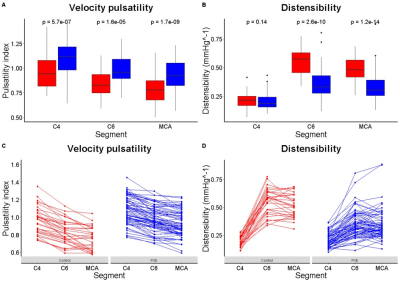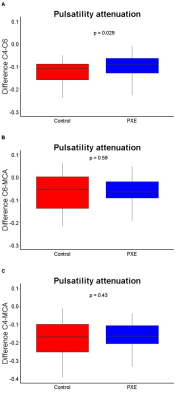Rick J. van Tuijl1, Jonas W. Bartstra1, Pim A. de Jong1, Willem P. T. M. Mali1, Irene C. van der Schaaf1, Ynte M. Ruigrok2, Gabriël J. E. Rinkel2, Birgitta K. Velthuis1, Wilko Jason Spiering3, and Jaco J. M. Zwanenburg1
1Radiology, UMC Utrecht, Utrecht, Netherlands, 2Neurology, UMC Utrecht, Utrecht, Netherlands, 3Vascular Medicine, UMC Utrecht, Utrecht, Netherlands
1Radiology, UMC Utrecht, Utrecht, Netherlands, 2Neurology, UMC Utrecht, Utrecht, Netherlands, 3Vascular Medicine, UMC Utrecht, Utrecht, Netherlands
Compared to matched controls, patients with pseudoxanthoma elasticum
(PXE; rare disorder) show lower distensibility and higher velocity pulsatility
in the carotid artery. However, pulsatility attenuation over the carotid siphon
is very similar.

Figure 1: Pulsatility index and
distensibility in PXE patients (blue) and healthy controls (red). Difference in A) pulsatility index and B)
distensibility in healthy controls and PXE patients in different segments of
the ICA and MCA. Lower panel: spaghetti plots of C) pulsatility index and D)
distensibility to visualize consistency in behavior over the segments for the
individual measurements.

Figure 2: Differences in pulsatility attenuation
between PXE patients (blue) and healthy controls (red) between A) the C4
segment of the ICA and the MCA, B) the C4 and C6 segment of the ICA and C) the
C6 segment of the ICA and the MCA. Although PXE patients showed slightly less
pulsatility attenuation between C4 and C6 the net attenuation between
